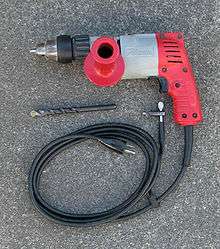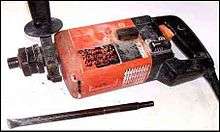Hammer drill

A hammer drill, also known as a "rotary hammer", "roto-drill" or "hammering drill", (see also rotary drill) is a rotary drill with a hammering action. The hammering action provides a short, rapid hammer thrust to pulverize relatively brittle material and provide quicker drilling with less effort. These tools are usually electrically powered, and increasingly powered by batteries. The same technology is also used in electric "demolition hammers", also known as "chipping guns" or "breakers".
Types: "Cam-Action" (Percussion) and "Electro-Pneumatic"
Lower power units are usually called "hammer drills," typically have a "cam-action" or "percussion" hammering mechanism, in which two sets of toothed gears mechanically interact with each other to hammer while rotating the drill bit. With "cam-action" drills, the chuck has a mechanism whereby the entire chuck and bit move forward and backwards on the axis of rotation, the motion is tied to the rotation of the chuck. This type of drill is often used with and without the hammer action but it is not possible to use the hammer action alone as it is the rotation over the "cams" which causes the hammer motion. These units are usually smaller and are commonly powered by cordless technology. They are not typically used for production construction drilling, but rather for occasional drilling of concrete or masonry.
More advanced power units, usually labeled rotary hammers, tend to be larger and provide a bigger impact force by utilizing a technology called the "electro-pneumatic" (EP) hammering mechanism," because it is powered directly by electricity, instead of a separate air compressor. An EP hammer has two pistons—a drive piston, and a flying piston. An electric motor turns a crank, which moves the drive piston back and forth in a cylinder. The flying piston is at the other end of the same cylinder. The pistons do not actually touch, but the air pressure in the EP cylinder allows for a much more efficient transfer of hammering energy than springs in the cam-action style tools. The majority of modern rotary hammers as well as all electric-powered chipping guns or jack-hammers all utilize this EP technology. Modern units allow the hammer and rotation functions to be used separately or in combination, i.e., hammer mode, drill mode, or both. When used in the hammer mode, the tool provides a drilling function similar to a jackhammer.[1]
Hammer drills of both working principles are well suited for drilling holes in masonry or stone. They are also both used to drill holes in concrete footings to pin concrete wall forms and to drill holes in concrete floors to pin wall framing. Larger rotary hammers can also be used for "doweling" (repetitive drilling of large rebar anchor holes), and through-holes in concrete and masonry walls. The hammering action helps to break up the masonry so that it can be removed by the drill bit's flutes.
Use
A hammer drill has a specially designed clutch that allows it to not only spin the drill bit, but also to punch it in and out (along the axis of the bit). The actual distance the bit travels in and out and the force of its blow are both very small, and the hammering action is very rapid—thousands of "BPM" (blows per minute) or "IPM" (impacts per minute). Although each blow is of relatively low force, these thousands of blows per minute are more than adequate to break up concrete or brick, using the masonry drill bit's carbide wedge to pulverize it for the spiral flutes to whisk away. For this reason, a hammer drill drills much faster than a regular drill through concrete or brick. Holes in hard materials are needed for anchor bolts, concrete screws and wall plugs.
Hammer drills almost always have a lever or switch that locks off the special "hammer clutch," turning the tool into a conventional drill for wood or metal work. Hammer drills are more expensive and more bulky than regular drills, but are preferable for applications where the material to be drilled—concrete block or wood studs—is unknown. For example, an electrician would use a hammer drill for attaching items (such as an electrical box) to either wood studs (if used as a conventional power drill) or masonry walls (if used as a hammer drill).
Rotary hammers


Rotary hammers, also called "combi drills," are similar in that they also pound the drill bit in and out while it is spinning. However, they use a piston mechanism instead of a special clutch. This causes them to deliver a much more powerful hammer blow, making it possible to drill bigger holes much faster. Rotary hammers have such force, in fact, that the usual masonry bits are no longer adequate. Their smooth shanks would be pounded loose from the tool's chuck in a few seconds. Rotary hammers require special bits which lock into the rotary hammer and continue spinning while smashing away.
A number of "special shanks" have been developed by various manufacturers. Over the years a fair number of these proprietary systems evolved, but the remaining shanks in use today are: SDS+, SDS-MAX, and SPLINE SHANK. These shanks were developed in order to allow for the bit to "slide" back and forth while rotating, so that the drill bit can efficiently transfer the force of the electro-pneumatic hammering mechanism to the working surface.
Rotary hammer drills have an oil filled gearbox, which allows them to operate durably despite the large forces and shocks they receive and the grit-filled environments where they are often used.
Apart from their main function of drilling concrete, the rotary action can be switched off and use is made of just the percussive force. Chisel and point accessories are used for small chipping jobs.
The type of work they do means that they require a "slip-clutch" which engages when the drill bit jams and sufficient torque is put onto the "slip-clutch" mechanism. This stops the violent wrenching motion that a drill without a clutch would cause when stopped suddenly from full speed, protecting the drill from damage. The slip-clutch also protects the operator, but does not always prevent injury. Some manufacturers have introduced additional technology to protect the operator. Hilti has a technology called "ATC" or "Active Torque Control"[2] which works by disengaging the drive from the motor when the tool body begins to rotate excessively through the action of a secondary magnetic clutch in addition to the standard slip-clutch. DeWALT has a related system called "CTC" or "Complete Torque Control"[3] which utilizes a two-position slip-clutch so that the operator can select the lower torque setting for greater safety.
Jams are most often caused by hitting reinforcing steel or by a worn bit. In both cases the drill must be disengaged from the bit and the jammed bit backed out of the hole with vise grips or monkey wrench. Some bits utilize a full carbide "four-cutter" head with a geometry that makes jamming less common - even when rebar is present. These full-carbide "four-cutter" bits can even, in some instances, drill through rebar, although this should be done with caution.
A worn drill bit will still drill a horizontal hole, although of a slightly smaller diameter than one created when it was new. When a drill like this is used to drill holes down into a concrete slab, the flutes are so worn that they can no longer lift the dust out of the hole; the concrete dust packs up in the hole and jams the bit.
History
The origin of the first hammer drill is a matter of contention.
German company Fein patented a "Bohrmaschine mit elektro-pneumatischem Schlagwerk" in 1914. German company Bosch produced the first "Bosch-Hammer" around 1932 in mass production. The US-american company Milwaukee Electric Tool Corporation states that in 1935, it was selling a lightweight 1/4-inch electric hammer drill (cam-action).[4] Company Hilti had the first "electro-pneumatic" rotary hammer on the market in 1967, the Hilti TE 17[5]
See also
References
- ↑ "How's It Work? Rotary Hammers". Pro Tool Reviews Magazine. Retrieved 22 September 2013.
- ↑ "Hilti Online - Active Torque Control (ATC)". Hilti.com. 29 January 2009. Archived from the original on February 22, 2014. Retrieved 17 February 2014.
- ↑ "D25712K 1-7/8" SDS Max Combination Hammer with SHOCKS - Active VibrationVibration Control & 2 Stage Clutch". Dewalt.com. Retrieved 17 February 2014.
- ↑ "History of Milwaukee". Milwaukee Tool. Retrieved 17 February 2014.
- ↑ "Hilti Online - History". Hilti.com. 29 January 2009. Archived from the original on February 22, 2014. Retrieved 17 February 2014.
External links
- How's It Work? Rotary Hammers, interview with Trey Sklar at protoolreviews.com
- NIOSH Sound Power and Vibrations Database
- New York City Quiet Vendor Guidelines